
ZS Enterprises uses long time proven and new effective technologies
together with high quality materials from reputable suppliers

|
|
||||||||||
|
Copper has been used by humanity since the Bronze Age. Copper is a reddish metal with a face-centered cubic crystalline structure. It is malleable, ductile, and a good conductor. It is softer than iron but harder than zinc and can be polished to a bright finish. Copper has low chemical reactivity. In moist air it slowly forms a greenish surface film (usually a mixture of carbonate, sulfate, hydroxide, and oxide) called patina; this coating protects the metal from further attack. The chemical composition and physical properties together with technical and economic aspects have for centuries made copper the material of choice for covering buildings and homes. Consideration must be taken about color properties of copper, which change gradually throughout the time of the installed roof system. The color typically changes from reddish metallic to brown, dark brown and gradually to gray-greenish as patina develops. This color deviation process can be sped up or avoided by "pre-weathering" process which is an "aging" method applying the patina coat artificially.
|
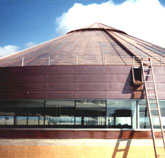 |
||
|
Zinc is a lustrous bluish-white metal which has good atmospheric resistance. The surface of zinc develops a blue-gray layer (the patina - zinc carbonate - mixture of zinc oxide and zinc hydroxide), which is responsible for the high corrosion resistance of zinc. The patination speed can vary between five months and five years, depending on climatic conditions. No major color changes are apparent during the patination process as with copper. Due to the chemical, technical and economic aspects, which include such considerations as life expectancy, cost, ease of maintenance or requirements for cleaning and servicing, zinc has often been a superior choice in building construction. |
 |
||
|
Steel is an alloy of iron, carbon, and small proportions of other elements. Steel is often classified by its carbon content: a high-carbon steel is serviceable for dies and cutting tools because of its great hardness and brittleness; low- or medium-carbon steel is used for sheeting and structural forms because of its amenability to welding and tooling. In roofing steel has been widely used in resent years for design flexibility. It can be used for pitched, flat or arched construction on virtually any type of building. Steel roof decks offer a low cost relative to their strength-to-weight ratios. For installers, steel sheets represent a relatively easy-to-use system that can be installed quickly and easily. For owners, steel installations denote lower initial cost with reasonably good durability. Requirements for maintenance of steel systems is generally higher then those of copper or zinc. |
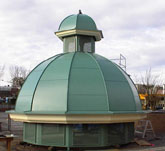 |
||
|
Lead was known to the ancient Egyptians and Babylonians. The Romans used it for pipes and in solder. Lead is a dense, relatively soft, malleable metal with low tensile strength. It is a poor conductor of electricity and heat. Although lead has a lustrous silver-blue appearance when freshly cut, it darkens upon exposure to moist air because of the rapid formation of an oxide film; the film protects the metal from further oxidation or corrosion. In construction the specific properties of lead and architectural requirements may situate this metal as the best candidate for a new or a reconstructed application. |
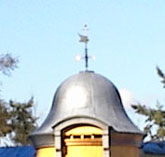 |
||
|
Where lead on its own may be to fragile or where we need the copper properties but not its color or the color fluctuation, lead coated copper is likely the candidate. This combined material is extremely durable and may be the solution for specific architectural designs. |
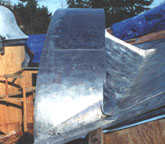 |
||
|
Stone was one of the first building materials used in human history. Each of us can picture at least one historical structure built of stone. This gives slate an excellent credit when we consider that the lifetime of a building begins with the choice of materials. Designers and architects have always been inspired by the elegance of this natural material. These esthetic properties together with the practical qualities (such as resistance to weather aspirations, heat and fire withstanding and life expectancy) have influenced designers of many, many buildings. As a natural material, slate can have almost unlimited range of differences in light absorption, striation, shape and texture. This allows for enhanced architectural vision and creation of individual visual effects for each application. |
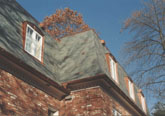 |
||